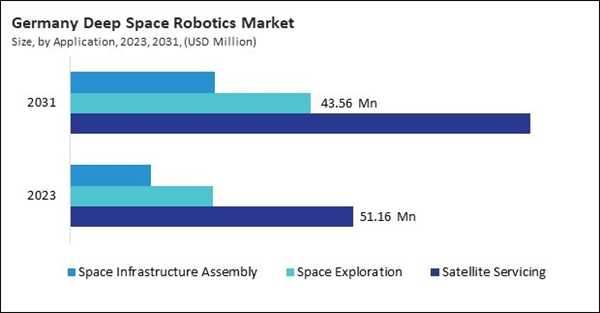The Europe Deep Space Robotics Market is expected to witness market growth of 7.6% CAGR during the forecast period (2024-2031).
The Germany market dominated the Europe Deep Space Robotics Market by country in 2023, and is expected to continue to be a dominant market till 2031; thereby, achieving a market value of $153 million by 2031. The UK market is exhibiting a CAGR of 7% during 2024-2031. Additionally, the France market is expected to experience a CAGR of 8.4% during 2024-2031.
The applications of deep space robotics are as vast as the universe itself, reflecting the diverse needs of space exploration and utilization. One of the most prominent uses is planetary exploration, where robots such as rovers and landers traverse alien landscapes to gather data on surface conditions, atmospheric composition, and potential signs of life. NASA’s Mars rovers, for instance, have set the standard for such missions, with each iteration - most recently the Perseverance rover - demonstrating enhanced capabilities in sample collection and analysis. These robotic explorers are indispensable for missions to distant moons like Europa or Titan, where human presence is unfeasible due to environmental extremes.
Another critical application is satellite servicing, a growing necessity as the number of satellites in orbit increases. Deep space robots equipped with manipulator arms and advanced sensors can repair, refuel, or reposition satellites, extending their operational lifespans and reducing space debris. This capability is vital for geostationary satellites, which play a key role in telecommunications and weather monitoring. Companies like Northrop Grumman have already demonstrated success with their Mission Extension Vehicles, signalling a shift toward sustainable space operations.
The steady growth of the European space sector highlights its commitment to deep-space exploration, necessitating advancements in robotics for mission efficiency and safety. The rise in spacecraft production signifies a greater emphasis on autonomous space systems, including robotic arms, rovers, and AI-driven probes that can operate in extreme extraterrestrial conditions. Agencies like the European Space Agency (ESA) are investing in robotic technologies to support upcoming missions, including lunar and Mars explorations.
The Germany market dominated the Europe Deep Space Robotics Market by country in 2023, and is expected to continue to be a dominant market till 2031; thereby, achieving a market value of $153 million by 2031. The UK market is exhibiting a CAGR of 7% during 2024-2031. Additionally, the France market is expected to experience a CAGR of 8.4% during 2024-2031.
The applications of deep space robotics are as vast as the universe itself, reflecting the diverse needs of space exploration and utilization. One of the most prominent uses is planetary exploration, where robots such as rovers and landers traverse alien landscapes to gather data on surface conditions, atmospheric composition, and potential signs of life. NASA’s Mars rovers, for instance, have set the standard for such missions, with each iteration - most recently the Perseverance rover - demonstrating enhanced capabilities in sample collection and analysis. These robotic explorers are indispensable for missions to distant moons like Europa or Titan, where human presence is unfeasible due to environmental extremes.
Another critical application is satellite servicing, a growing necessity as the number of satellites in orbit increases. Deep space robots equipped with manipulator arms and advanced sensors can repair, refuel, or reposition satellites, extending their operational lifespans and reducing space debris. This capability is vital for geostationary satellites, which play a key role in telecommunications and weather monitoring. Companies like Northrop Grumman have already demonstrated success with their Mission Extension Vehicles, signalling a shift toward sustainable space operations.
The steady growth of the European space sector highlights its commitment to deep-space exploration, necessitating advancements in robotics for mission efficiency and safety. The rise in spacecraft production signifies a greater emphasis on autonomous space systems, including robotic arms, rovers, and AI-driven probes that can operate in extreme extraterrestrial conditions. Agencies like the European Space Agency (ESA) are investing in robotic technologies to support upcoming missions, including lunar and Mars explorations.
List of Key Companies Profiled
- Space Applications Services NV/SA
- Lunar Resources, Inc.
- Honeybee Robotics (Ensign-Bickford Industries, Inc.)
- Ceres Robotics Inc.
- Astrobotic Technology, Inc.
- Northrop Grumman Corporation
- Redwire Corporation (Made In Space, Inc.)
- iRobot Corporation
- Metecs, LLC
- Motiv Space Systems Inc.
Market Report Segmentation
By End User
- Government
- Commercial
By Application
- Satellite Servicing
- Space Exploration
- Space Infrastructure Assembly
By Solution
- Services
- Remotely Operated Vehicles
- Remote Manipulator System
- Software
By Country
- Germany
- UK
- France
- Russia
- Spain
- Italy
- Rest of Europe
Table of Contents
Chapter 1. Market Scope & Methodology
Chapter 2. Market at a Glance
Chapter 3. Market Overview
Chapter 4. Europe Deep Space Robotics Market by End User
Chapter 5. Europe Deep Space Robotics Market by Application
Chapter 6. Europe Deep Space Robotics Market by Solution
Chapter 7. Europe Deep Space Robotics Market by Country
Chapter 8. Company Profiles
Companies Mentioned
- Space Applications Services NV/SA
- Lunar Resources, Inc.
- Honeybee Robotics (Ensign-Bickford Industries, Inc.)
- Ceres Robotics Inc.
- Astrobotic Technology, Inc.
- Northrop Grumman Corporation
- Redwire Corporation (Made In Space, Inc.)
- iRobot Corporation
- Metecs, LLC
- Motiv Space Systems Inc.
Methodology

LOADING...









